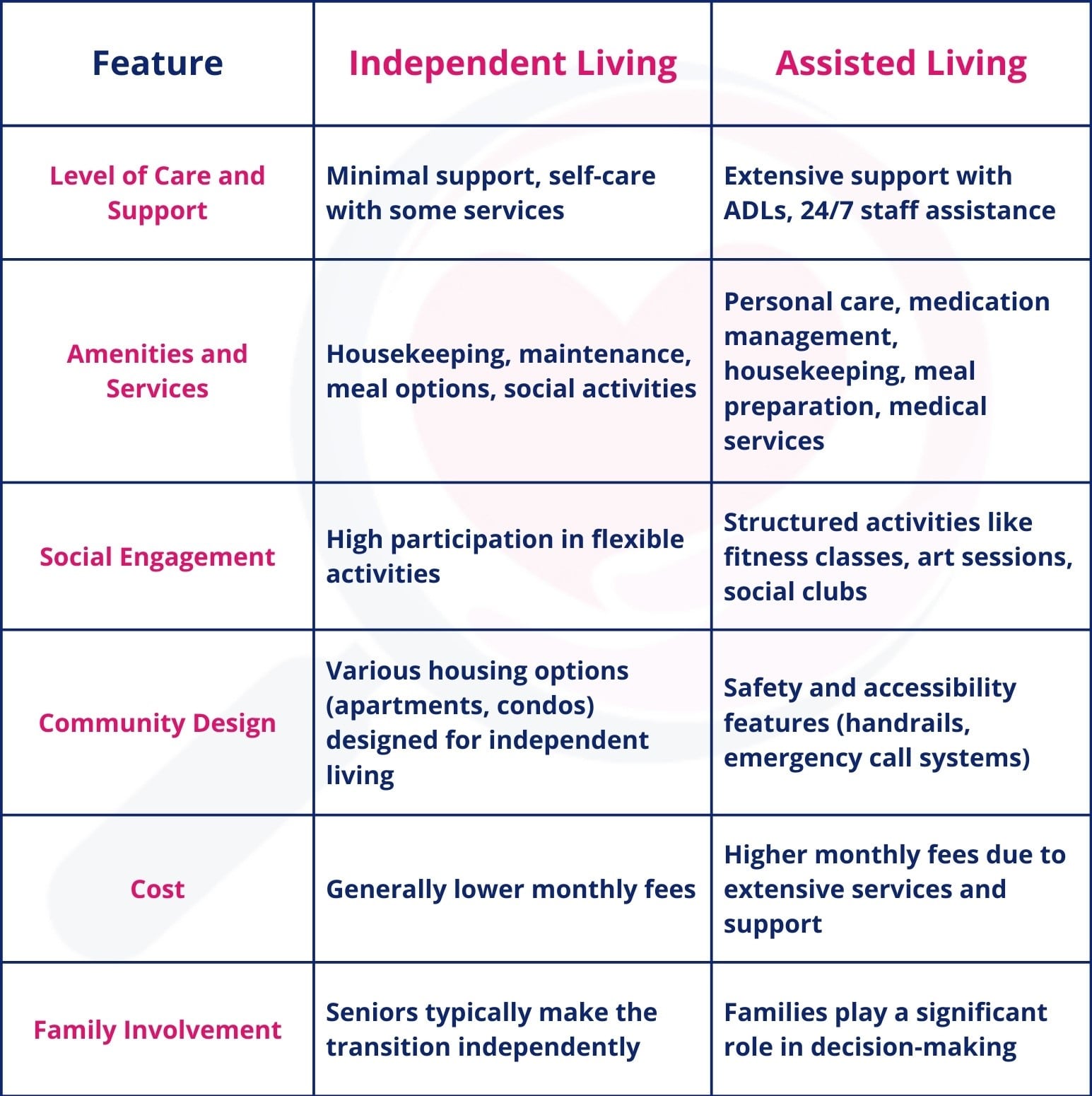Choosing the right living arrangement is critical for seniors’ quality of life and well-being. As people age, they often encounter retirement challenges like adjusting to health changes, maintaining social connections, and managing finances. Understanding the key differences between assisted living vs independent living is essential as it directly impacts these aspects of senior life.
By 2030, all baby boomers will be over 65, according to the U.S. Census Bureau. This will increase the senior population and the demand for diverse living options. This change emphasizes the importance of understanding the differences of senior living options, especially between assisted living and independent living.
As seniors consider their housing options within senior living communities, it is crucial to understand the differences between each senior living option, such as assisted living and independent living. Choosing between assisted living and independent living impacts seniors’ daily happiness and ability to care for themselves. These choices also address common concerns like losing independence, becoming a burden, and wanting to stay active and social. Understanding the differences between each senior living option is essential for making the best decision.
This guide clearly explains the key differences between assisted living and independent living. It helps families and seniors make informed decisions.
What is Assisted Living?
Assisted living facilities provide a unique mix of independence and support. They cater to seniors who value their freedom but need help with activities of daily living (ADLs).
These communities provide a wide range of services including meal preparation, housekeeping, medication management, and personal care assistance. The environment is carefully designed for safety and comfort. It includes features such as handrails, emergency call systems, and staff available 24/7 to meet residents’ needs, and provide peace of mind for both the seniors and their families. Programs are also in place to handle various health conditions, ensuring that each resident receives personalized care.
According to the American Health Care Association (AHCA) and National Center for Assisted Living (NCAL), over 800,000 Americans live in assisted living settings. There are approximately 30,600 assisted living communities with 1.2 million licensed beds in the United States today, reflecting the growing demand for senior care options that balance independence with support.
The American Health Care Association notes that the average resident may receive help with three or more activities of daily living, such as bathing, dressing, and medication management. For more on assessing needs, consider reading “Time for Assisted Living? Assessing ADLs“.
What is Independent Living?
Independent living facilities caters to self-sufficient seniors who want the convenience and social activities community living offers. These facilities often feature private apartments with full kitchens, alongside ample community spaces for socializing, activities, and events. Medical care is less emphasized in these communities. However, they offer amenities like wellness programs, transportation services, and dining options, promoting an active and engaging lifestyle.
For those considering this lifestyle, “Is Independent Living Right for You?“ offers additional insights.
Key Differences: Assisted Living vs. Independent Living
-
Level of Care and Support
Assisted living facilities provide extensive support tailored to the needs of seniors who require regular help with their daily routines. This comprehensive support includes assistance with activities of daily living (ADLs), such as bathing, dressing, and medication management.
This type of senior living provides services like meal preparation to meet nutritional needs and transportation for medical appointments or social outings. This level of care is designed for seniors who are no longer fully independent, but do not need the constant care of a nursing home.
In contrast, independent living is suited for seniors who are largely autonomous but seek to live in an environment that minimizes the burdens of daily housekeeping and maintenance. These communities cater to seniors who can handle their own care and medication management, but who value the convenience of services like on-site maintenance, which frees them from the chores of upkeeping a home.
-
Amenities and Services
Assisted living facilities often have on-site medical centers to handle both emergency and routine health needs. They also offer amenities such as dining room, housekeeping, and organized social events. The staff at these facilities are trained to provide comprehensive healthcare and support. In contrast, independent living communities emphasize lifestyle amenities, including fitness centers, clubs, and social gatherings, catering to a more independent senior lifestyle.
-
Social Engagement
Assisted living fosters an active community atmosphere. It offers structured activities such as fitness classes, art sessions, and social clubs to engage and connect residents. Independent living offers more flexibility, providing facilities for activities but allowing residents to choose their level of involvement.
-
Community Design
Assisted living communities are built with safety and accessibility as key priorities. Their designs include features that help people with limited mobility. Independent living communities offer various housing options, including apartments, condominiums, townhouses, and single-family homes. These options allow residents to choose from a range of lifestyle choices
-
Cost
Assisted living usually costs more because it needs many services and staff to support residents. This leads to a higher monthly fee. Independent living may be more affordable, with a lower monthly fee. However, prices vary widely depending on location, amenities, and housing type.
Check if any activities or services have additional fees to make sure they fit within your budget.
-
Family Involvement
Family members usually play a huge part in choosing assisted living because it needs more care and support. In independent living scenarios, seniors typically make the transition more independently, although family support is still important.
Here is a quick comparison of key differences between independent living vs assisted living:

Making the Decision
Consider the senior’s needs, preferences, budget, and future health. This will help you choose the best option between assisted and independent living. Families should consider the desired level of independence, need for medical assistance, and budget constraints.
Visit potential communities and talk with residents to understand the services and amenities firsthand. Discussing with family members can also provide invaluable insights for making the right choice.
How My Care Finders Can Help
My Care Finders excels in assisting families with these decisions. Our senior care advisors offer personalized consultations to understand each family’s unique needs and preferences, helping them choose the best senior living option available. We provide detailed information about various communities; help arrange tours and assist in navigating the financial aspects of senior living. Our advocacy ensures families feel confident and have peace of mind throughout the decision-making process.
Conclusion
Understanding the differences of assisted living vs independent living is essential for choosing the best option for a loved one. With comprehensive options available, My Care Finders is dedicated to guiding families through this process, ensuring that seniors find a living arrangement that best fits their lifestyle and needs.





